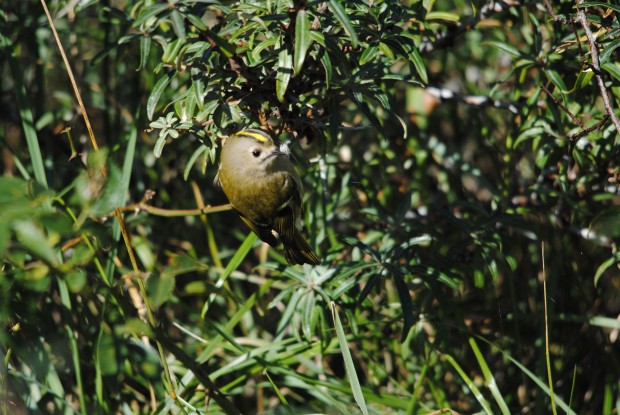Britain’s smallest bird!
This will be my last update for the reserve as it is my last week working as a Seasonal Ranger at the Falls of Clyde. So as part of this I thought I would talk about one of my favourite little birds that I have had the joy of seeing on the reserve.
Other than the treecreeper which I spoke about in a previous blog, there are other shy birds in our woodlands. I am of course talking about the United Kingdom’s smallest bird, and no I am not talking about the wren which is often what people think to be the smallest bird. This honour in fact goes to goldcrest, which is a small greyish-green bird. Its most recognisable feature however is on the top of its head with it having a gold stripe with a black stripe on either side. This is what gives the goldcrest its name.

Goldcrests tend to live in conifers as their small beaks allow them to pick up insects in between the pine needles. They especially love spiders as this makes up a large amount of their diet and can often be seen hovering in front of spider webs. Another reason that they hard to see is that they like to feed at the tops of trees. Their call is also really interesting as it is really high pitch which means that you may struggle to hear the goldcrest singing the older that you get. The song goes “tweedly tweedly tweedly twiddleedidee”, and the call is a “zi-zi-zi”.
As their food is found in conifers this also means that they nest in the same spot. The nest is usually a small ball shape on the end of a conifer branch and tends to be made of lichen, moss, cobwebs and hair. The eggs take sixteen days to hatch and they can have between nine and eleven eggs in each nest. It is the female who makes the nest while the male brings in the food. It is quite unusual for birds but the goldcrest will overlap two broods where they will actually start the second brood while the young from the first brood are still in the nest.
This tiny little bird also once had the nickname ‘woodcock pilot’ as it is hard to imagine that it can migrate over the North Sea. People once thought that goldcrests rode on the backs of migrating short-eared owls and woodcock. Goldcrests found to be nesting in Britain don’t tend to move too far away from their nests. It is in actual fact goldcrests from the continent that fly through.
I hope this has inspired you to keep a lookout for the smallest bird we have and if you have any sightings it would be great if you could email fallsofclyde@scottishwildlifetrust.org.uk!
Mike Butler – Falls of Clyde Seasonal Ranger, Scottish Wildlife Trust
Help support our vital work and join us today!
Help protect Scotland’s wildlife
Our work to save Scotland’s wildlife is made possible thanks to the generosity of our members and supporters.
Join today from just £3 a month to help protect the species you love.
Preface
This will be my last update for the reserve as it is my last week working as a Seasonal Ranger at the Falls of Clyde. So as part of this …
